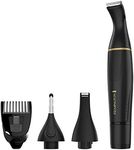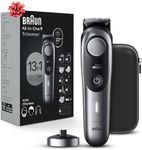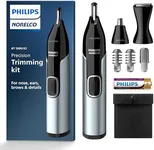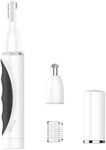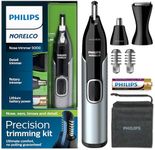Buying Guide for the Best Nose Trimmers
Choosing the right nose trimmer can make personal grooming easier, safer, and more comfortable. The best nose trimmer for you will depend on your grooming habits, sensitivity, and preferences for convenience. Understanding the key features will help you find a trimmer that fits your needs and ensures a smooth, painless experience.Blade TypeThe blade type refers to the material and design of the cutting blades inside the trimmer. This is important because it affects how efficiently and safely the trimmer cuts hair. Most nose trimmers use stainless steel blades, which are durable and rust-resistant, while some may offer hypoallergenic coatings for sensitive skin. When comparing blade types, look for those that are rounded or have protective guards to prevent nicks and irritation. If you have sensitive skin or are prone to allergies, choosing a hypoallergenic or specially coated blade can be beneficial.
Power SourceNose trimmers can be powered by batteries, rechargeable batteries, or sometimes by plugging into a wall outlet. This matters because it affects portability and convenience. Battery-operated trimmers are great for travel and quick use, while rechargeable models are more eco-friendly and cost-effective over time. If you travel often or want a trimmer for on-the-go use, a battery-powered or USB-rechargeable model is ideal. For home use, a plug-in or rechargeable trimmer may be more suitable.
Water ResistanceWater resistance indicates whether the trimmer can be used in wet environments or cleaned under running water. This is important for hygiene and ease of cleaning. Some trimmers are fully waterproof and can be used in the shower, while others are only splash-proof or must be kept dry. If you prefer to groom in the shower or want easy cleaning, look for a waterproof model. If you only plan to use it dry, water resistance may be less important.
Cutting Head DesignThe cutting head design refers to the shape and size of the part that enters the nostril. This affects comfort, precision, and safety. Some trimmers have a rotary head that spins to cut hair from all angles, while others use a straight or angled head for targeted trimming. Rotary heads are generally more comfortable and efficient for most users, while straight heads can offer more control for detailed grooming. If you want quick, all-around trimming, a rotary head is a good choice. For more precise work, consider a straight or angled head.
Noise LevelNoise level refers to how loud the trimmer is during operation. This can be important if you are sensitive to noise or plan to use the trimmer in shared spaces. Trimmers with quieter motors are more comfortable to use and less likely to disturb others. If you value a peaceful grooming experience, look for models that are specifically described as quiet or low-noise.
Ease of CleaningEase of cleaning is about how simple it is to keep the trimmer hygienic. Some trimmers have detachable heads that can be rinsed under water, while others require a brush for cleaning. A trimmer that is easy to clean will save you time and help prevent buildup of hair and bacteria. If you want minimal maintenance, choose a model with washable or detachable parts.
